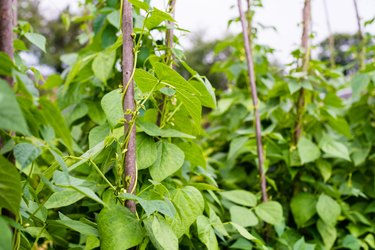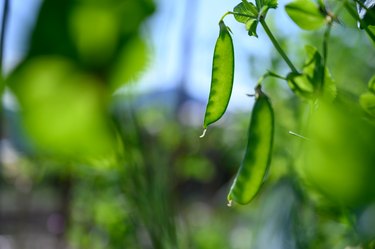
Native to Central and South America, common beans (Phaseolus vulgaris) are an important food source for people all over the globe. Beans are flowering plants with roots, stems and leaves. As legumes ‒ plants that can extract nitrogen from the air ‒ beans also have specialized components.
Bean Parts and Functions
Video of the Day
Bean plants grow either in the form of bushes or vines. Beans that grow in vine form are known as pole beans and have twining stems, though they do not have tendrils. Bean plants have trifoliate compound leaves. Each of the three leaflets are oval-shaped. Bean plants produce pealike flowers that may be yellow, pink, red or white.
Video of the Day
All bean plants produce pods, known as legumes, that contain multiple seeds. The pods dehisce, which means they split open along two sutures. Depending on the type of bean, the pod may be yellow, green or purple. Beans with yellow pods are commonly referred to as wax beans.
Bean plants send down a deep taproot. However, they also produce lateral roots closer to the surface of the soil. The roots of bean plants have special nodes that convert nitrogen from the air into a form of the element that the plant can use. These unique parts of a bean plant are distinct features of legumes.
Bean Plant Care
While bush beans do not require any support and are generally easier to care for, pole beans must be trained on a trellis to support the pods. The vines, which can be up to 6 feet long, should be trained onto supports in such a way that all the bean parts receive plenty of air and sunlight. Because of how shallow their lateral roots are, always be gentle when removing weeds or cultivating the soil around bean plants to avoid damaging the root system.

You also want to avoid planting beans or other legumes in the same spot in consecutive years. This is considered a best practice because the pests and diseases that affect beans can remain in the soil for long periods of time. If at any point you notice the leaves of your bean plant turning yellow or shriveling, remove the plant to prevent any potential pathogens from spreading.
Harvesting Bean Pods
Bean plants are usually divided into three categories depending on when seed pods are ready to be harvested and eaten. The pods of snap beans, also known as string beans or green beans, are harvested when the seeds are still immature. Both the seeds and the pods of snap beans are edible.

Shelling beans, which include garbanzo and fava beans, are harvested when the seeds are fully formed, and the pod has become thin and tough but has not fully dried out yet. The pods of shelling beans are not edible. Chickpeas and fava beans are examples of shelling beans.
Dry beans, which include kidney, navy and pinto beans among others, are harvested when the pod is dry. The pods are discarded. You know dry beans are ready to be harvested when you can hear the dry beans rattling inside the pod.
- University of Illinois Extension: Beans
- Oregon State University: Summarize the Distinctive Physical Characteristics of Legumes
- University of Minnesota Extension: Growing Beans in Home Gardens
- New Mexico State University: Nitrogen Fixation by Legumes
- PlantVillage: Bean
- Missouri Botanical Garden: Phaseolus vulgaris